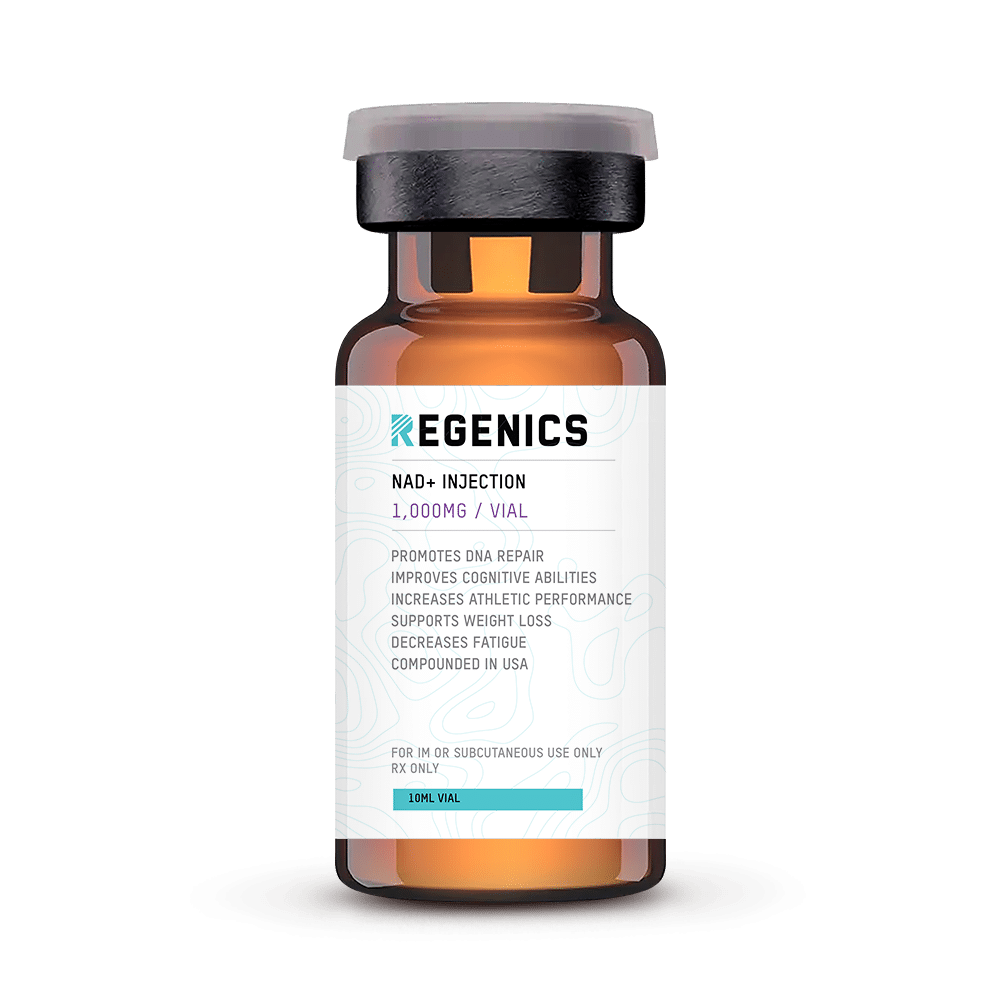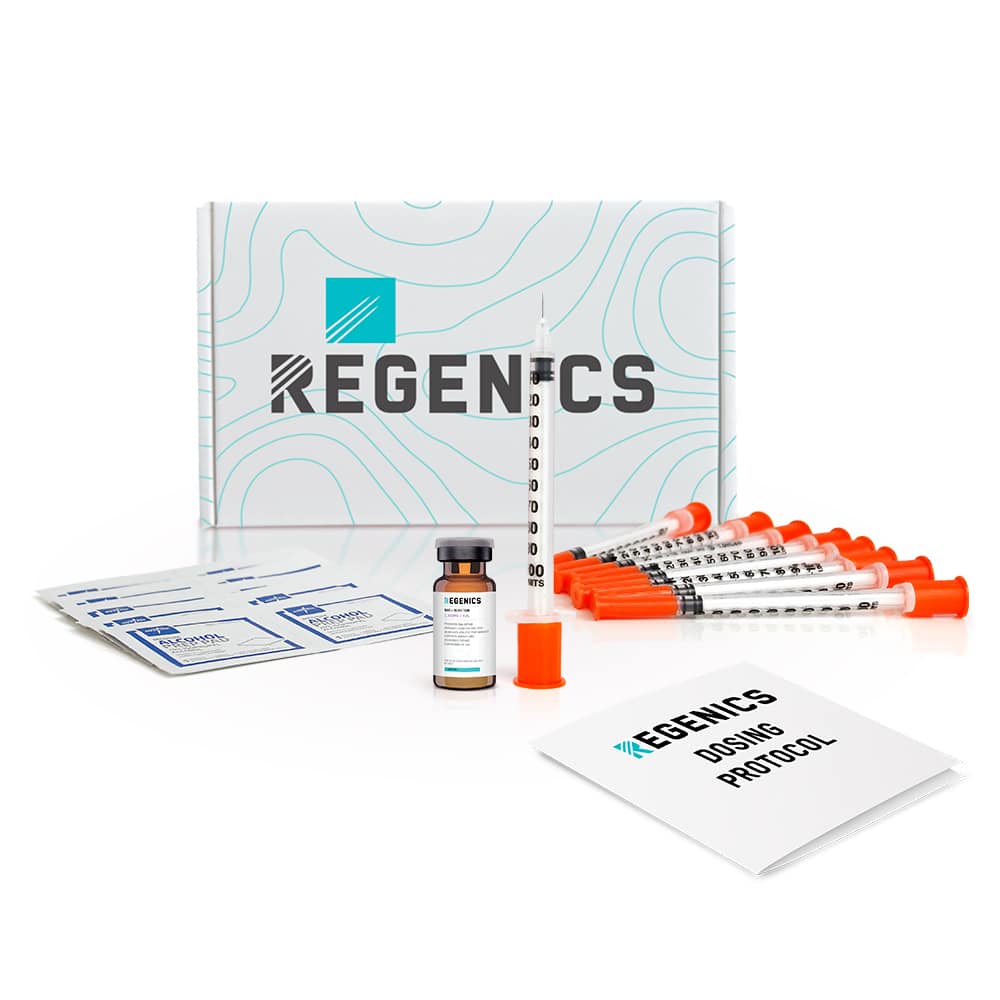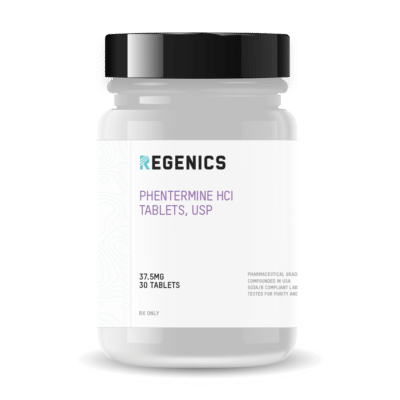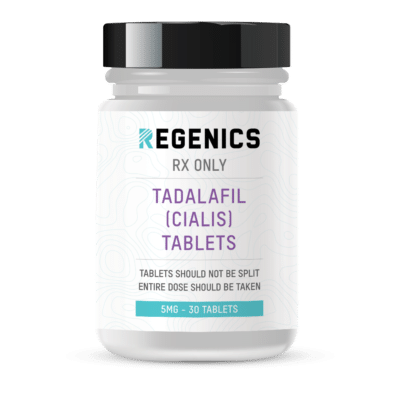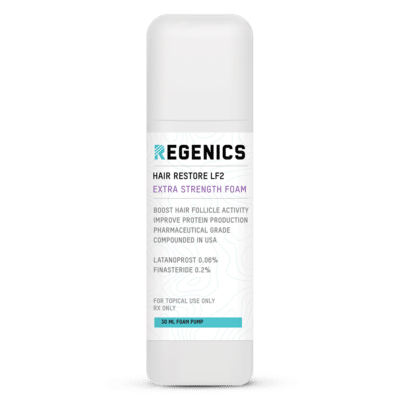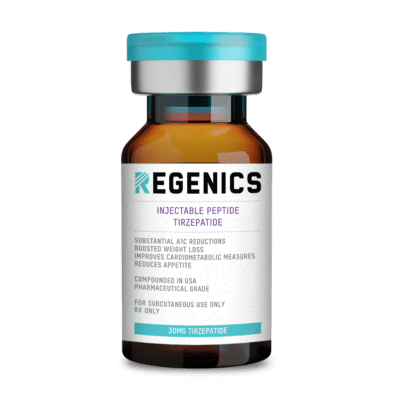NAD+ Injections
- PROMOTES DNA REPAIR
- IMPROVES COGNITIVE ABILITIES
- INCREASES ATHLETIC PERFORMANCE
- SUPPORTS WEIGHT LOSS
- DECREASES FATIGUE
- COMPOUNDED IN USA
- FOR IM OR SUBCUTANEOUS USE ONLY
*NAD+ IV Infusions available in office
$449.00 – $799.00 — or Auto-refill and save up to 10%
Description
This medication requires a prescription. Learn more about how Regenics uses free telehealth consults with our licensed medical providers to prescribe and fill this medication.
Nicotinamide adenine dinucleotide (NAD) is one of the most essential molecules in your body. In fact, you’ll find it in every single cell working in more chemical reactions than any other vitamin-derived molecule. When the molecule has oxidized and becomes inactive, it is known as NADH, but in its active form, it is known as NAD+. NAD+ is a coenzyme of the Vitamin B3 that activates reactions after binding to protein molecules.
At-Home Injection Kit Includes:
1 NAD+ lyophilized vial
1 10ml bacteriostatic water vial
1 mixing syringe
Injecting syringes
Alcohol wipes
Dosing Instructions
Injecting Instructions
Nicotinamide Adenine Dinucleotide (NAD+) is a prevalent cellular electron transporter, coenzyme, and signaling molecule found in all cells of the body and is vital for cell function and viability.12 Its reduced (NADH) and phosphorylated forms (NADP+ and NADPH) are as important as NAD+.12 Each step of cellular respiration—glycolysis in the cytoplasm, the Krebs cycle, and the electron transport chain in the mitochondria—requires the presence of NAD+ and NADH, their redox partner.
The manufacture of cholesterol and nucleic acids, elongation of fatty acids, and regeneration of glutathione, a vital antioxidant in the body, are just a few anabolic processes that frequently require NADP+ and NADPH.3 NAD+-dependent/-consuming enzymes modify proteins post-translationally in various cellular processes using NAD+ and its other forms as substrates.12 NAD+ also acts as a precursor for cyclic ADP ribose, an essential component of calcium signaling and a secondary messenger molecule.4
The amino acid tryptophan and the vitamin precursors nicotinic acid and nicotinamide, often known as vitamin B3 or niacin, are used by the body to naturally produce NAD+. It can also be produced from biosynthetic intermediates including nicotinamide mononucleotide and nicotinamide riboside.23 NAD+ is continuously recycled within cells as it transitions between its many forms through salvage mechanisms.3 Mammalian cells may be able to take up extracellular NAD+, according to studies on cell culture.5
The highest NAD+ levels are found in neonates, and they gradually decrease with increasing chronological age.6 They are around half of what they are in younger persons after age 50.6 Model organisms have been used to study the subject of why NAD+ levels fall with aging.78 However, during other metabolic activities, NAD+ is consumed by NAD+-dependent enzymes and may subsequently become depleted over time, contributing to increased DNA damage, age-related illnesses and diseases, and mitochondrial malfunction. During redox reactions, NAD+ and NADH are not consumed but rather continually regenerated.26 Views of aging and senescence frequently highlight a deterioration in mitochondrial health and function with age, and investigations of NAD+ depletion and the associated oxidative stress and damage corroborate these theories.12
The age-related drop in NAD+ levels is caused by rising levels of CD38, a membrane-bound NADase that degrades both NAD+ and its precursor nicotinamide mononucleotide, according to a 2016 study in mice, which exhibit age-related declines in NAD+ levels similar to those seen in humans.7 The study also demonstrated that human adipose tissue from older adults (mean age, 61 years) expresses the CD38 gene at higher levels than that of younger adults (mean age, 34 years).7 Other research in mice, however, has shown that oxidative stress and inflammation brought on by aging lower NAD+ production.8 Therefore, it is likely that a number of mechanisms work together to cause individuals to lose NAD+ as they age.
When it was recognized that pellagra, a condition marked by diarrhea, dermatitis, dementia, and mortality, could be treated with foods containing NAD+ precursors, particularly vitamin B3, the clinical significance of maintaining NAD+ levels was established in the early 1900s.9 Notably, the skin does not flush with NAD+ injection, in contrast to vitamin B3 (niacin) intake, which also causes this negative effect.10 Low NAD+ levels have recently been associated with a variety of age-related ailments and diseases linked to increased oxidative/free radical damage, including diabetes,11 heart disease,812 vascular dysfunction,13 ischemic brain injury,14 Alzheimer’s disease,1516 and vision loss.17
Since a 1961 report by Paul O’Hollaren, MD, of Shadel Hospital in Seattle, Washington, NAD+ IV infusion has been widely utilized for the treatment of addiction.181920 In more than 100 instances, Dr. O’Hollaren detailed the effective use of IV-infused NAD+ for the prevention, relief, or treatment of acute and chronic symptoms of addiction to a range of substances, including alcohol, heroin, opium extract, morphine, dihydromorphine, meperidine, codeine, cocaine, amphetamines, barbiturates, and tranquilizers.18 The security and effectiveness of NAD+ treatment for addiction, however, have not yet been assessed in clinical trials.
NAD+-replacement therapy may encourage optimal mitochondrial function and homeostasis, genomic stability, neuroprotection, long life, and may help with addiction treatment.12320 Clinical trials assessing these effects in humans receiving NAD+ injection have not yet been published; nevertheless, many clinical trials assessing the effectiveness and safety of NAD+-replacement therapy or augmentation in the context of human disease and aging have recently been completed, and many more are currently underway.
Unknown are the precise mechanisms of NAD+ repair or enhancement for potential health benefits, such as supporting healthy aging and treating age-related illnesses, metabolic and mitochondrial diseases, and addiction12320
In order to prevent mitochondrial malfunction and sustain metabolic function/energy generation (ATP), NAD+ supplementation may counterbalance the age-related degradation of NAD+ and its precursor nicotinamide mononucleotide by NADases, particularly CD38.7 NAD+ replenishment, however, appears to support a number of other metabolic pathways via NAD+-dependent enzymes in research involving human and animal models (as well as samples and cell lines).12320
There are numerous well-known NAD+-dependent enzymes. Poly-ADP ribose polymerases (PARP 1–17) control nuclear stability and DNA repair.13 cADP-ribose, ADP-ribose, and nicotinic acid adenine dinucleotides are produced by NADases CD38 and CD157 in Ca2+ signaling and intercellular immunological communication.13 A family of histone deacetylases known as sirtuins (Sirt 1-7) controls a number of proteins involved in cellular metabolism, stress responses, circadian rhythms, and endocrine functions. Sirts have also been linked to longevity in model organisms and protective effects in cardiac and neuronal models.13 A recently identified NAD+ hydrolase, Sterile Alpha and Toll/Interleukin-1 Receptor motif-containing 1 (SARM1), is implicated in the aging and regeneration of neurons.2122
The mechanism of action of NAD+ replenishment has been somewhat clarified by research on progeroid (premature aging) disorders, which resemble the clinical and molecular aspects of aging. It is believed that the Werner syndrome (WS), which is characterized by severe metabolic dysfunction, dyslipidemia, early atherosclerosis, and insulin resistance diabetes, most closely resembles the aging process.23 The source of WS is the Werner (WRN) DNA helicase gene24, which regulates the transcription of the essential NAD+ 25biosynthetic enzyme Nicotinamide Nucleotide Adenylyltransferase 1.
NAD+ depletion through disruption of mitochondrial homeostasis is a substantial contributor to the metabolic dysfunction in WS, according to a 2019 study.25 WS patient samples and WS animal models’ NAD+-deficient cells showed impaired mitophagy (selective degradation of defective mitochondria).25 NAD+ repletion restored NAD+ metabolic profiles, improved fat metabolism, lowered mitochondrial oxidative stress, and improved mitochondrial integrity in human cells with mutant WRN via restoring normal mitophagy.25 In animal models, NAD+ repletion significantly increased lifespan, delayed the beginning of accelerated aging, and increased the number of proliferating stem cells in the germ line.25 Several NAD+ precursor molecules were released to replace NAD+, demonstrating that NAD+ replacement is what generates the beneficial effects.25
More evidence of NAD+’s significance in promoting mitochondrial and metabolic health may be seen in murine cells overexpressing the NADase CD38, which also had greater lactate levels, aberrant mitochondria, including missing or enlarged cristae, and lower oxygen consumption.7 Isolated mitochondria from these cells showed a substantial reduction in NAD+ and NADH compared to controls. In CD38-deficient animals, NAD+ levels, mitochondrial respiratory rates, and metabolic activities remained constant with age.7
A set of 11 healthy male individuals (n=8 for NAD+ and n=3 for controls) participated in a pharmacokinetic study to examine how changes in NAD+ and its metabolite concentrations during NAD+ IV infusion affected the subjects’ overall health. Over the course of six hours, participants received a 750 mg dosage of NAD+ through an IV infusion at a rate of three moles per minute. NAD+, nicotinamide, and adenosine phosphoribose (ADPR) plasma levels were all substantially greater than those in the control group (p<.001, p<.001, and p<.0001, respectively) as a result of this, relative to baseline (p<.0001).10 After 8 hours, there was no difference in nicotinamide or ADPR levels across the groups, although there was a difference in NAD+ levels.10 Over the course of the 8-hour period, levels of these two NAD+ byproducts were substantially correlated in both groups (=1.0, p<.001), suggesting that NADases like CD38 may be in charge of cleaving NAD+ to nicotinamide and ADPR.10
Plasma levels of nicotinamide’s metabolites, methylnicotinamide (350%) and nicotinamide mononucleotide (NMN; 472%), also significantly increased at the end of the NAD+ infusion compared to baseline and the control group (p<.0001 and p<.05, respectively), which is consistent with increased nicotinamide.10
NAD+ levels excreted in the urine of the NAD+ group were significantly higher (538%) after infusion (at 6 h) compared to those tested at 30 minutes (p<.001); they were also significantly different from the controls (p<.05).10 This level decreased by 43% at the 8-hour time point relative to the peak at 6 hours (p <.05).10
Urine contains more NAD+ and its metabolites.10 The NAD+ group’s nicotinamide urine excretion levels remained stable during an 8-hour period, but those of methylnicotinamide significantly increased (403 percent) following infusion (at 6 h) compared to that assessed at 30 minutes (p<.01).10 In comparison to the high at 6 hours, this level likewise dropped by 43% at the 8-hour mark (p <.05).10
Notably, no significant increases in plasma or urine levels of NAD+ or its metabolites were observed within the first 2 hours of infusion, indicating rapid and complete tissue uptake and/or metabolism (at least for the first 2 hours).10
Notably, within the first two hours after infusion, no discernible increases in plasma or urine levels of NAD+ or its metabolites were seen, indicating quick and thorough tissue absorption and/or metabolism (at least for the first 2 hours).1 NAD+ injections’ impact on intracellular and compartmental NAD+ pools, however, is not yet known.1
At the time of writing, there were no other reported contraindications/precautions for NAD+ injection. Individuals with known allergy to NAD+ injection should not use this product.
The safety of NAD+ injection has not been evaluated in pregnant women. Due to this lack of safety data, pregnant women should avoid NAD+ injection.
The safety of NAD+ injection has not been evaluated in women who are breastfeeding or children. Due to this lack of safety data, women who are breastfeeding and children should avoid NAD+ injection.
.
At the time of writing, there were no reported interactions for NAD+ injection. It is possible that unknown interactions exist.
Injection of NAD+ seems to be secure and well-tolerated.10 The injection of NAD+ may cause adverse reactions and side effects, such as headache, shortness of breath, constipation,18 increased plasma bilirubin, and decreased levels of gamma glutamyl transferase, lactate dehydrogenase, and aspartate aminotransferase.10
Case studies of the use of NAD+ to treat drug addiction offered early information on side effects and safety.1819 According to a 1961 study, patients with addiction who got NAD+ at a moderate IV drip rate (no more than 35 drops per minute) reported “no distress” but those who received it at a quicker drip rate complained of headache and shortness of breath.18 In this study, the dosage was 500–1000 mg per day for 4 days, then two injections every week for a month, and then one injection every two months as a maintenance dose. One of the two patients who had therapy reported experiencing constipation.18
In a 2019 study, a cohort of healthy male participants (n=11; NAD+ n = 8 and Control n = 3) aged 30-55 years had their safety of IV infusion of NAD+ evaluated using liver function tests (serum, total bilirubin, alkaline phosphatase, alanine aminotransferase, gamma glutamyl transferase, lactate dehydrogenase, and aspartate aminotransfer.10 Neither the NAD+ cohort nor the placebo (saline) cohort experienced any negative side effects throughout the 6 hour infusion.10 At 8 hours following the start of the NAD+ infusion, it was shown that the NAD+ group had significant declines in the liver function enzymes gamma glutamyl transferase, lactate dehydrogenase, and aspartate aminotransferase as well as a large increase in plasma bilirubin.10 The modifications, however, were not regarded as clinically important. Because of the limited sample sizes, notably for the control group, which are acknowledged by the authors, these results should be evaluated with care.10
Store this medication at 68°F to 77°F (20°C to 25°C) and away from heat, moisture and light. Keep all medicine out of the reach of children. Throw away any unused medicine after the beyond use date. Do not flush unused medications or pour down a sink or drain.
Additional information
| Potency | 500mg, 1000mg, 2000mg |
|---|
